Guest Post: Pat Penny – Yiwu - Tea Technique Research Trip 2025
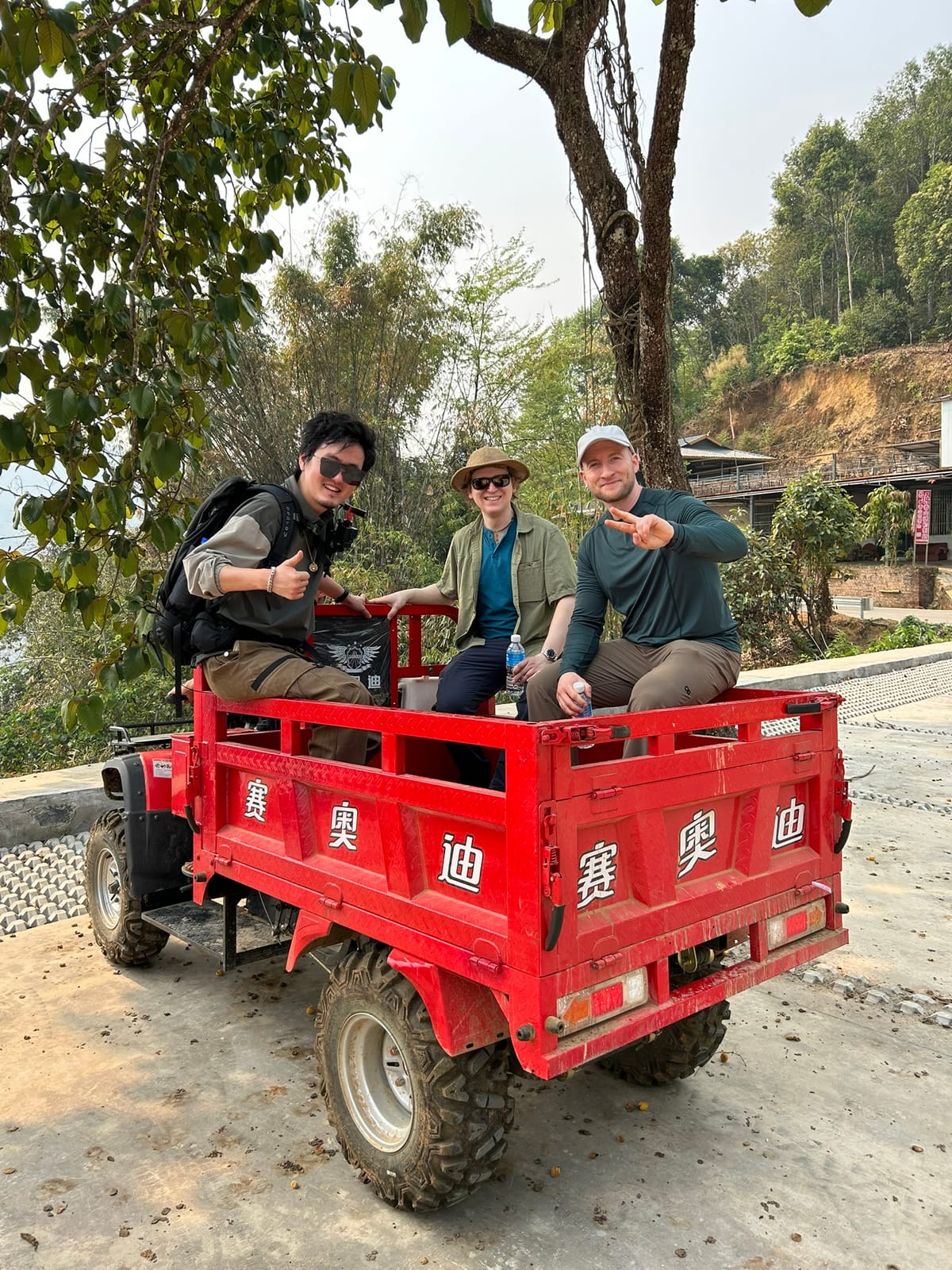
Here it is folks, my personal mecca of tea trips – Yiwu, Yunnan. We battled the bugs, the snakes, and the escalating political tensions and tariffs to go and study with a variety of knowledgeable Charen in Yiwu and the experience did not disappoint.
Yiwu has been a bucket list tea destination for me for as long as I’ve loved tea. I remember a distinctly warm September afternoon in 2010 drinking tea at the Tea Institute at Penn State [now defunct] and coming across a raw pu’er from Yiwu. I was relatively new to premium Chinese tea, and I had never tried pu’er before that moment, but that was certainly one of the many serendipitous sips that led to a life-long love of the leaf. Yiwu was a homecoming of sorts, tasting the teas that I first fell in love with all those years ago.
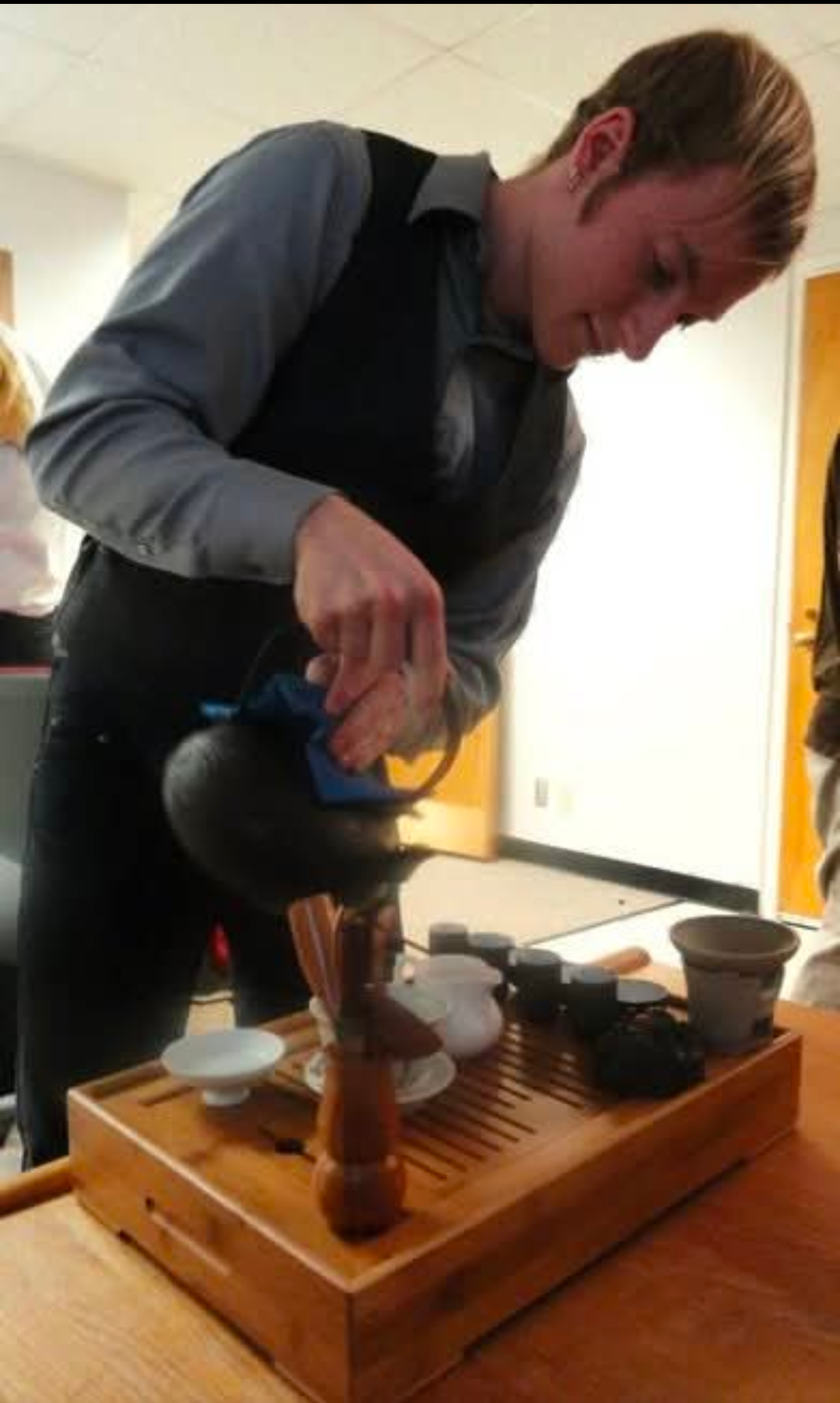
Sitting here typing this report a few weeks post trip, I can confidently say that this was the most productive Tea Technique research trip to date – and dare I say it – one of the best tea trips I’ve ever had. That’s honestly saying a lot – you can scroll back on this very blog and see many a story from tea trips past: Battling stray dogs to do extreme chaxi in the mountains of Taiwan (and by the ocean in the eye of a typhoon), learning to walk with an Edosenke Iemoto, having tea with Korean immortality cults, making our own onggi wares in Korea, our own Yixing wares in Dingshu, the list of amazing tea moments could be a full page in its own right and yet it was this trip that will live on in my memory – not for its recency, but for the density of high quality information (and amazing relationships) found within this trip. Yiwu was everything I had hoped for and more. Our contacts were excellent – knowledgeable and generous with their time; the food was amazing (and no rat tartar to tempt us a la Wuyi); the land itself was beautiful beyond my expectations; and lastly, although we learned last year that this is crucial, the weather was perfect for our plans, with the rain holding out until the final day of our trip in Yiwu.
The team spent a little over a week in Yiwu. During that time, we explored a variety of neighboring locales: Mahei (麻黑, including Shimenkan (石门坎)), Luoshuidong (落水洞), Da Qi Shu (大漆树), Yibang (倚邦), Mansong (曼松), Wanzishan (王子山), Mangzhi (莽枝), Gedeng (革登), Gaoshanzhai (高山寨; both East side and Bajiaolin (芭蕉林)), and more. We spent time with producer families, which of course included drinking a lot of tea – and we had the opportunity to make a lot of tea. So as I scroll back through my photo album and see hundreds of pictures of leaves, woks, and morning mixian (rice noodles) – what is it that I really learned with my time in Yiwu?
Yiwu Drift – 2 General 2 Uncalibrated
I know what you are thinking – Finally someone is going to write about Yiwu’s secret mountain drag racing scene. While our hosts had some sick driving skills going up and down winding mountain passes in their 4 wheel drive pick-up trucks, moves that literally induced heart burn in me, moves that occasionally involved stopping just mere seconds and inches from a head on collision with full-on construction vehicles and large utility vehicles, moves that Vin Diesel is going to incorporate in FFX2 (not final fantasy – fast and furious, although that is the mashup we’ve all been secretly waiting for…Just imagine Yuna summoning Dwayne “THE ROCK” Johnson instead of Bahamut…), this section is actually about my uncalibrated palate.
Going into this trip I thought I had a decent idea of what Yiwu tea tasted like. I’ve had plenty of samples from small Chinese and Taiwanese boutique brands, western vendors, and larger factory productions that all claim to be Yiwu. I was even arrogant enough to believe that I knew what a few sub-appellations’ key tastes to be based on a few sets of samples across a small range of producers. Luckily it only took me a day or two to realize that I knew far less about Yiwu pu’er than I thought I did– which in some ways was great, because I was in the right spot to rectify my references and learn the “true taste” of Yiwu tea.
Yes, Yiwu tea is softer than some of its Menghai (勐海), Simao (思茅), and Lincang (临沧) counterparts; Yes, long lingering sweetness and comfort in the throat are signs of good Yiwu tea. These hallmarks were no surprise. But as we tasted through dozens of teas, I found that many of my key identifiers for aged Yiwu were not present (effervescent mouthfeel, incense aroma, honey and dried fruit sweetness, papery/cloth note) in the young and mid-aged teas we were drinking. My theory is that most of the mid-aged and older “Yiwu” tea I’ve previously tasted were Taiwanese dry and natural storage, and while it’s possible that those quality indicators do not develop in (relatively) drier Yiwu storage, it has become clear to me that those specific quality indicators were based on material that was not 100% pure Yiwu tea. Much of the older tea was blended for price, flavor, and availability – and many of the flavors that I developed a preference for were the stronger flavors added to the tea from leaves originating outside of Yiwu.
We brought a few samples from various vendors (who will remain nameless to protect the innocent) of so-called “Yiwu” and “Yiwu gushu” tea to taste with our hosts, who are well respected experts in Yiwu and have been making tea for multiple generations. For many of these samples, our hosts were able to definitively show us why these teas were not Yiwu, not 100% Yiwu (i.e. a blend of yiwu and other material), and in some cases not gushu. This analysis was done with a combination of wet leaf evaluation, flavor, and other organoleptic properties (mouthfeel, throatfeel, body feeling, etc…). As our research team for this trip was composed entirely of professional product formulators, we can definitively say that this was not woo woo: no phrases like “this Qi is not Yiwu”; the skill level in identifying flavors, pulling other teas as reference, pulling notes from teas we had tasted in prior days, pointing out processing flaws and identifying attributes on the leaf we tasted, were all akin to the topmost level of blind wine identification. In the case of the blended sample, we could see the difference in the wet leaves. Short of analytical instrumentation, our hosts were able to break down these samples to their most base attributes and show us, not tell us, why these were not what they claimed to be. The thing these samples had in common was often excellent storage – that became the defacto “compliment” when our hosts didn’t want to insult the tea. “Ah this has good storage”, or “the storage was well managed” were commonly heard polite ways of letting us know these Yiwu samples were not what they claimed to be, and often were not up to the standards of our hosts, who would only take the slightest sip before dumping the tea into the waste water bin and inevitably taking out a sample of one of their own teas of a similar age to show us just how different a true 2009 Guafengzhai or 2003 Yiwu village blend is against samples with similar provenance claims. After the first or second sample that this happened, I thought that maybe our hosts just had a dispreference for teas stored in more humid locations (Guangzhou or Taiwan; which they do only to the extent that it overpowers the natural flavor of the tea), but upon drinking the gold standard teas they shared, I could more clearly understand the hallmark identifiers of quality they were looking for. One of these included a concept called “Tou” – this refers to a thoroughness or completeness of the tea’s processing and shows up as an experience of the tea that is extremely consistent from steep-to-steep, yielding teas with great longevity that produce flavors on their 15th and 20th brew (repeated flash steeping) that still have plenty in common with the second (after rinse and opening) or fifth steep.
The final level of calibration for me was tasting across gardens. We had the opportunity to sample small tree, large tree, ancient tree, single tree gaogan, second flush gushu, and mixed garden picks (blends of small and big tree, or big tree and gushu). While terminology and classification were inconsistent across producers, even within the same village, I found these tastings here in Yiwu really helped me better understand my own preferences. While I love the educational angle of single tree / gaogan tree teas (which for some producers is actually a blend of 2-3 gaogan trees and not truly single tree), and while these teas had amazing characteristics in terms of mouthfeel, energy, and purity – they often lack in flavor. This is well known, but I was able to try a much wider range of single tree gaogan samples at the source and determine that for me personally, these teas often aren’t worth seeking out at their price-point, even if they are amazing when evaluated within their own unique set of criteria. In my opinion, drinking wuwei qi water is for monks and rich laobans.
Part of these tasting experiences were done blind. This allowed the teas to stand on their own merits – without interference from my internal biases and allowed me to test my understanding of each type of materials unique characteristics. While we tasted plenty of gushu and gaogan teas, there were also small tree, big tree, and mixed picks scattered throughout. Through these specific blinded tasting I learned that I actually enjoy well processed small and big tree (non-gushu) tea, as well as mixed picks, when the teas are grown in an appropriately healthy environment from medium age (30+ yr) trees. Dearest reader, I’m not suggesting you turn to your nearest western facing vendor and ask for their youngest non-gushu tea…But after 15 years of drinking tea, it’s great to learn that for my daily drinkers a well processed big tree sheng from a biodiverse area may scratch the pu’er itch just as well as some gushu, with a reduced impact to my wallet. Particularly if I’m drinking for flavor and I don’t have the time to really sit with a gushu and experience some of its more internal characteristics (where of course gushu/gaogan tea far outclass small and big tree teas). At least that’s the case for high quality Yiwu pu’er; maybe I’ll wait for the Menghai trip before I apply the same learnings to other regions… Similarly, I found that I loved second flush gushu tea, which comes at a nice discount compared to first flush gushu, and tasted very familiar – Some of the purity, energy, and throat character of first flush gushu, but with a slightly more aggressive flavor profile. I’m actually less dubious of random vendors’ gushu claims coming out of this trip – sure I believe you could be selling me Chawangshu Gushu or Guafengzhai Gushu… but it might not be first flush! (which again, I often like!)
I’ll end this section with just about the most gatekeeping thing I can write – after this trip I will not be buying Yiwu pu’er through vendors, it’s farmer direct tea for me from now on. Western facing vendors perform a necessary service. Without them the barrier to entry for a hobby like premium tea would be insurmountable. Western vendors help newcomers develop their palates and build foundational knowledge. At 15 years of studying tea, tasting at the source, and developing a network of relationships, I finally feel that I’m no longer a novice, and now have access to teas that I could not acquire on the western market, at least not without significant markup. There are still many western vendors I trust and will probably continue to buy (non-yiwu) tea through, but my real recommendation to you dearest reader is that if you are single – marry a young man or woman who owns gushu tea gardens in Mansong.
Sub-appellation variation
Post calibration I was more sensitized to the nuances between regions. What helped most was actually going to some of these regions to physically see and experience the differences in soil, light, forest/canopy cover, elevation, slope, and the myriad other characteristics that make up each location’s terroir. One morning we went to Luoshuidong, Mahei, and Shimenkan. Shimenkan is thought of as a premium section of Mahei – with lots of good quality gushu. Luoshuidong is thought of by some producers as top tier Mahei, while others think of it as its own appellation. We were able to get from Luoshuidong tea trees to Mahei tea trees within about 3 minutes on a bumpy dirt trail car ride… so geographically these tea trees are super close. But the land was very different!
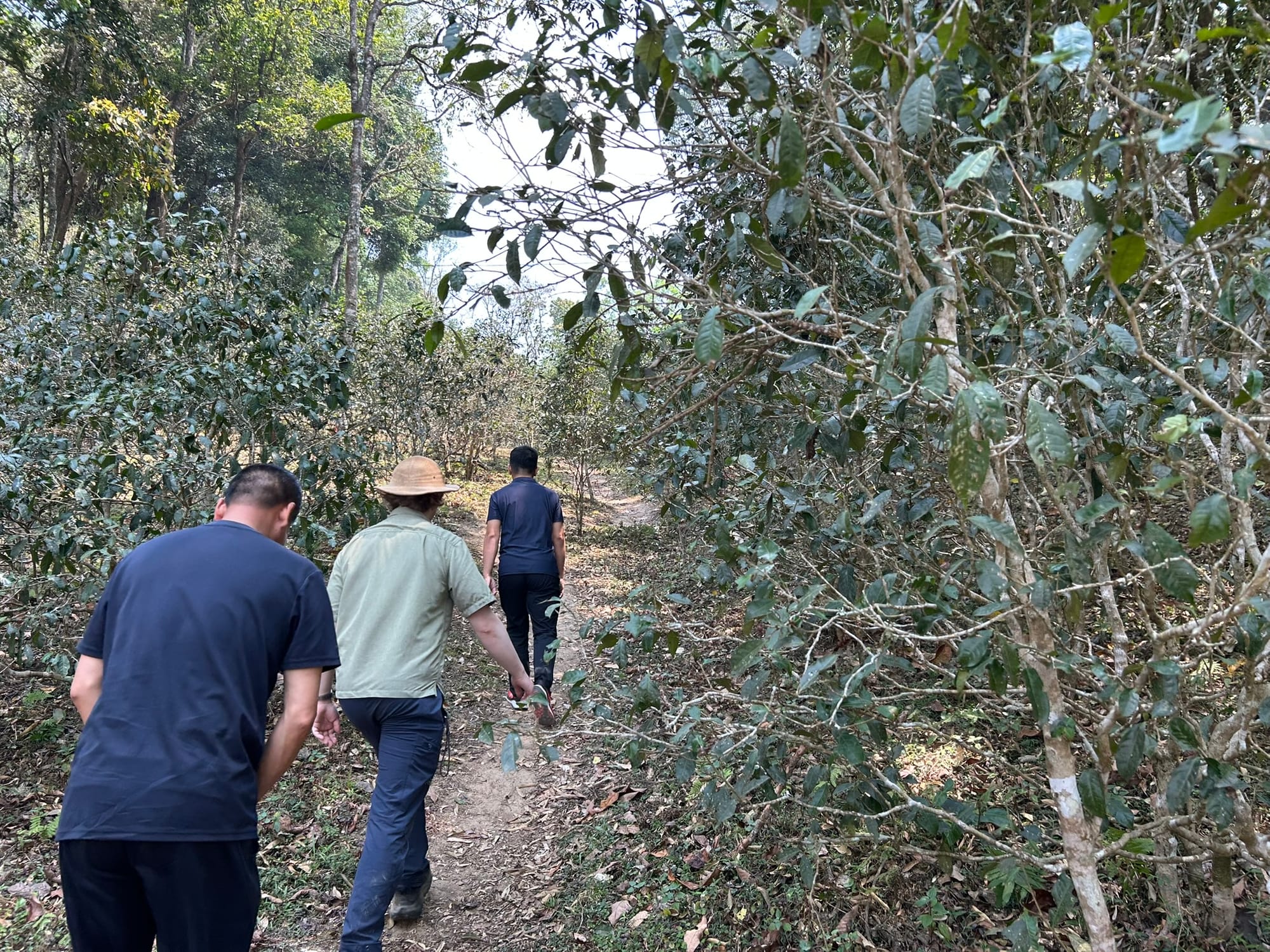
The areas of Shimenkan we walked were a bit more shaded, the slope was steep, but it did seem to be slightly higher altitude, and the tea trees were a bit older than what we saw in the generic Mahei area.
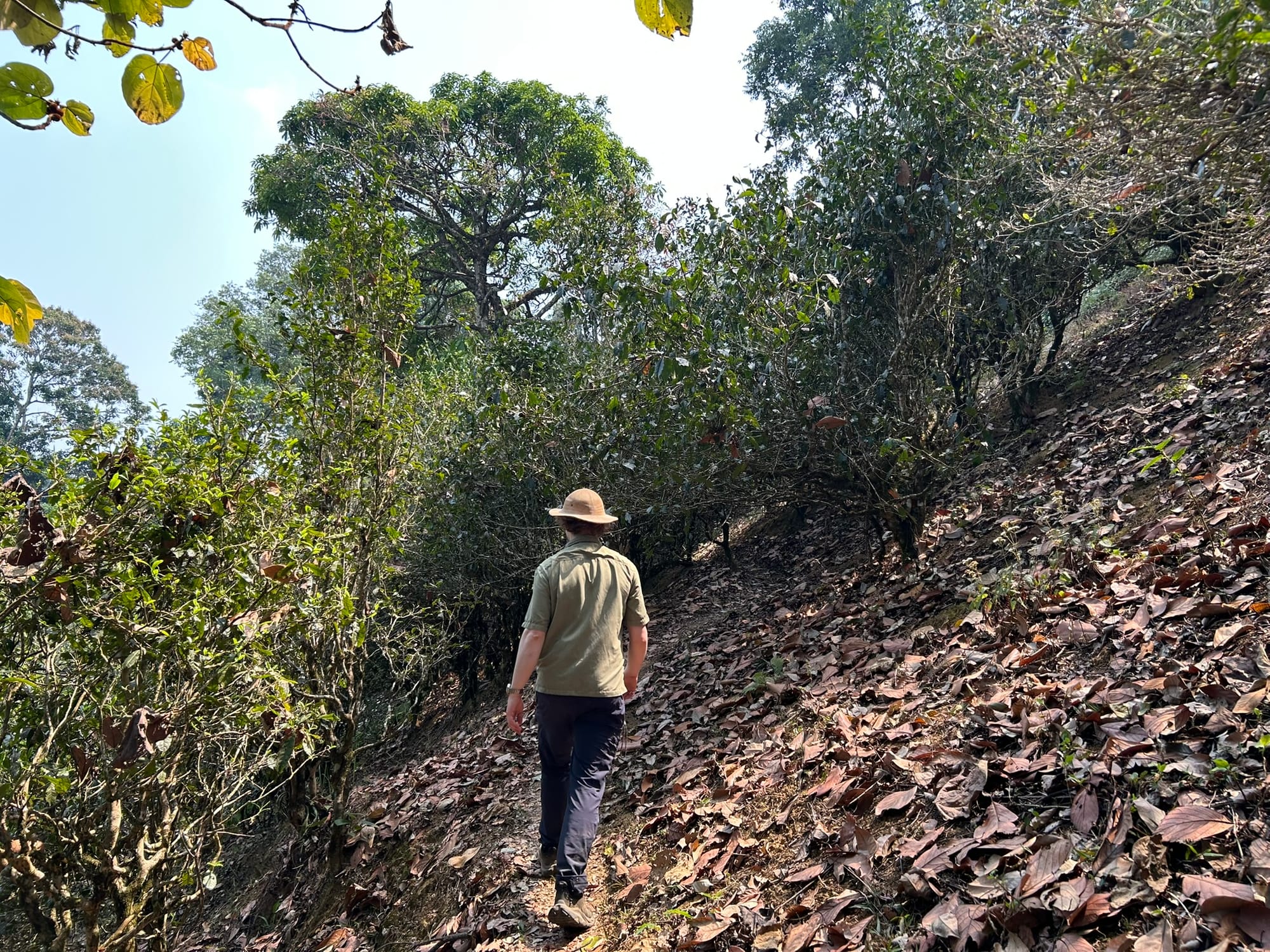
Luoshuidong was a bit lower in altitude and the sun seemed more direct, but on this day there was a great cross breeze and Luoshuidong actually felt cooler, and we saw a few really old trees including quite a few gaogan.
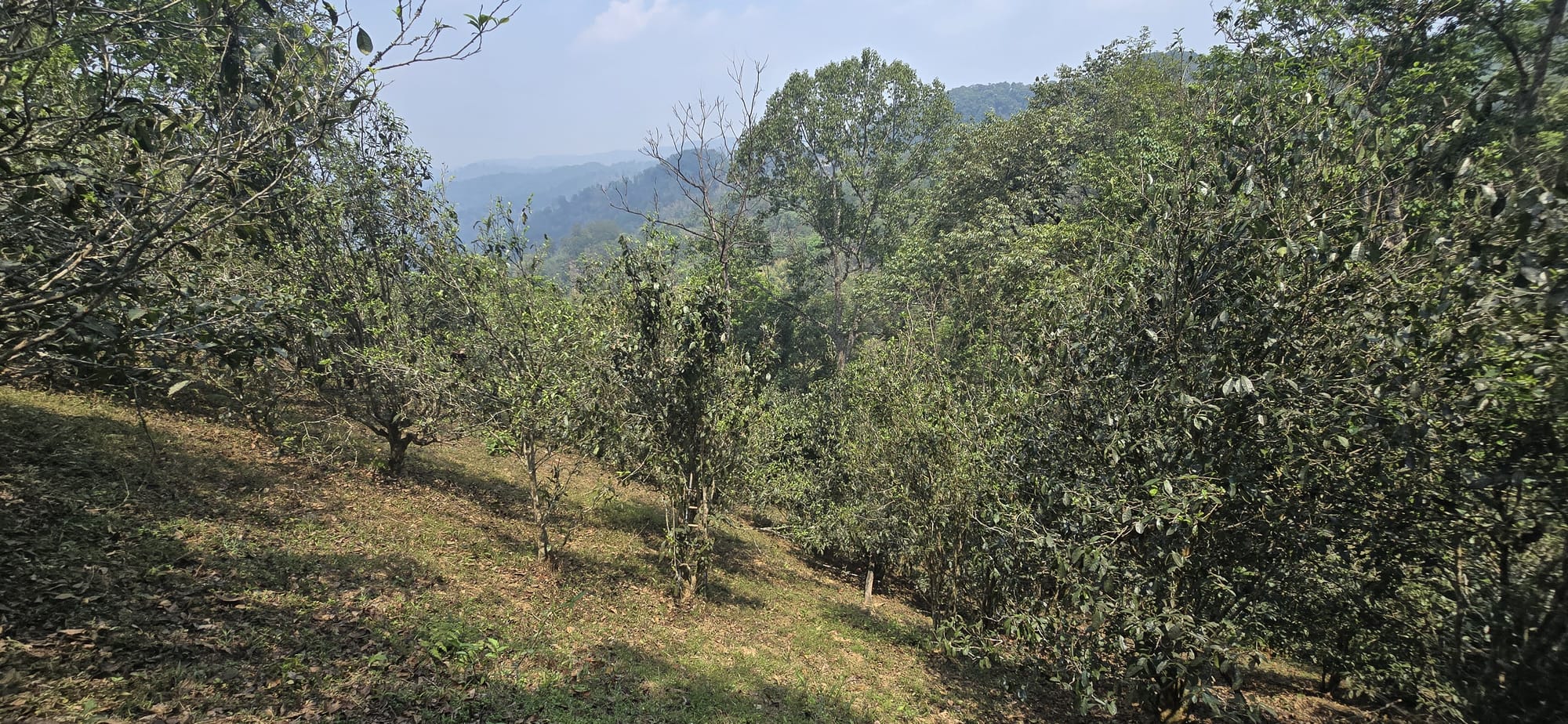
Such differences within a few kilometers walk! Upon returning to our host’s studio we drank a Mahei gushu, Shimenkan gushu, Luoshuidong gushu, and Luoshuidong gaogan danzhu (single tree) tea. The differences started to crystallize. The profiles got tighter, more refined, and purer in flavor and sensation. It’s an experience that I don’t think can be replicated without going to Yiwu (or at least not without a fat wallet and trustable source), but ultimately going forward, I will think of sub-appellation first in terms of land and terroir and less in terms flavor – the land-first approach is more likely to better generalize and help me understand how to classify and differentiate the quality of the tea based on its environment.
Mountain/Island Time
Something that really stuck with me was just how late everything started in Yiwu (and from what I understand, Yunnan at large). In all the other tea producing regions I’ve visited, and the many times that I’ve personally picked tea, picking started at the absolute ass-crack of dawn. 5am was not an unusual wake up time to be in the mountains by 6 or 6:30am. While I’m sure that across Yiwu there are a variety of different practices, I didn’t see pickers leaving for mountains until 7am or 8am. Picking also went much later then I’ve seen in other areas – with pickers returning to their designated processors as late as 7pm or 8pm, often with a second batch of picking (the earlier batch having been delivered midday so it wouldn’t sit in the heat for too long, and so that processing could start earlier). I would not have been able to wrap my head around this if I wasn’t in Yiwu. At the usual times that I’ve picked tea in the mornings in Korea, or Japan, or other parts of China, the light was just coming out at dawn. In Yiwu at 6am it is too dark and honestly too dangerous to be driving some of these mountain passes. The light is certainly an element of it, but I did get the feeling that there is something far more laid back about the culture in Yiwu, people float through the day, from house to house, friend to friend, and family to family, spending their time in a more leisurely manner then I’m used to from my usual 9-5 city life. I’m sure peak harvest is more hectic than what we saw during early season, but the vibe was truly laid back. It felt a bit like being at an island beach town, so what if you show up 30 minutes or an hour late? Things will start when they start, everything in its own time and on its own schedule. Even when drinking tea, I was told to slow down more than one time, to fully savor the feeling of the tea, to give it time to set in. It took a few days to get into the slowed down and settled pace of things in Yiwu, and leaving Yiwu I wish that pace stuck with me longer. At the very least when I go to brew Yiwu tea it’ll be a reminder to me of what life could be like in Yiwu Mountain Time.
Brewing Tea, Boiling Lao Paka
I can’t believe I’m going to admit this online… I’m back on team flash brew. At least for pu’er. After studying tea with Taiwanese teachers for so long I got used to lower doses and longer brews. My experiences in Chaozhou, Wuyi, and now Yiwu all challenged my brewing technique. My standard brewing parameters were lower in tea (let’s say 3-6g/100ml depending on the tea) and longer on time. In all 3 of these locations 8g/100ml seemed to be the starting point. For many teas I’ve felt the trade-offs weren’t worth these high dosages. But, for the producers we visited in Chaozhou and now Yiwu I’ve come back around to the advantages of flash steeps.
Brewing technique was straightforward in Yiwu. 8-10g of tea went in the gaiwan (always a gaiwan, I think we had tea out of a Yixing only once the whole trip), boiling water (or ~210F water since we were at 1000 – 1,200 meters of elevation) was added, the rinse was dumped, water was added again for <5 seconds, and was always poured into a gongdaobei. Brewing technique wasn’t sloppy, but it wasn’t particularly emphasized, with little to no exploration of other wares (kettles, brewing vessels, or drinking implements). The focus was strictly on evaluating the tea. Each tea was brewed at a minimum 15 times – “drinking to the bone” was talked about as much in Yiwu as it was in other locales like Chaozhou and was deemed critical to understanding a tea’s quality.
Something beautiful about these trips is that we always encounter a type of tea that is completely new to us. We had all drank single tree gaogan gushu before (flex), and had plenty of experience with small tree, large tree, ancient arbor, wild arbor, huang pian, etc…but none of us had tasted a real treasure of Yiwu before: Lao Paka. To my understanding Lao Paka is the material that is pruned off the trees in winter to encourage the spring flush. It is not really a flush in its own right, but just the collected trimmings of the pruning process and therefore it is very inexpensive. From what we were told this was often what pickers and farmers drink, particularly if they don’t want to cut into their expensive pu’er supply which they plan to sell. Lao Paka is picked, withered, blanched (dipped in boiling water to arrest oxidation as opposed to pan firing), and then dried. In its dry form it looks like…well autumn leaf pile. It is not brewed, but boiled, and we often saw it being sort of steamed – placed in a chamber at the top of a water boiling kettle and continuously boiled. The tea it yields is full bodied, leafy, and a touch medicinal. It is easy drinking and seems to be preferred by locals over just drinking water. Both families that hosted us said they boil the same batch of leaves all day, just adding water as the kettle empties.

Processing Tea
The most painful and greatest experience of this trip was making tea. We had a handful of opportunities to hand fire pu’er from a variety of locations. While our hosts rightfully didn’t let us handle too much gushu or material from super rare locales, they were extremely generous in teaching us how to pan fire and letting us not-quite-ruin a few too many batches of hard picker labor (supposedly we were making acceptable tea by the end of the trip, 200kg later).
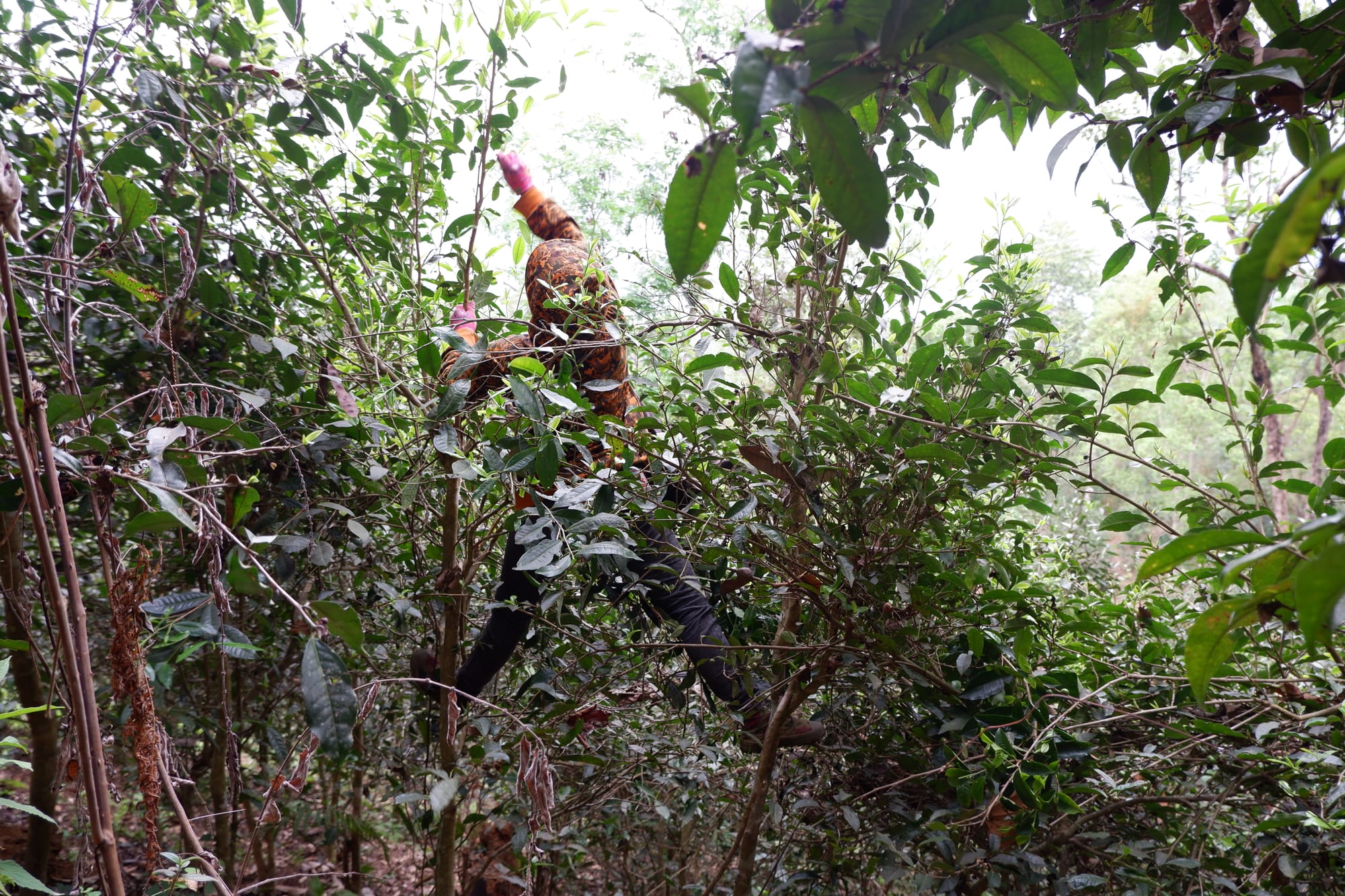
The first day we hand processed was in gaoshan – I spent about 15 to 20 grueling minutes over the hot wok, mostly burning my hands. Our host and his brother-in-law made the technique look seamless, but of course, once it was our turn, we quickly realized just how much skill we had to develop to manage a hot wok filled with ~10kg of steaming hot leaves.
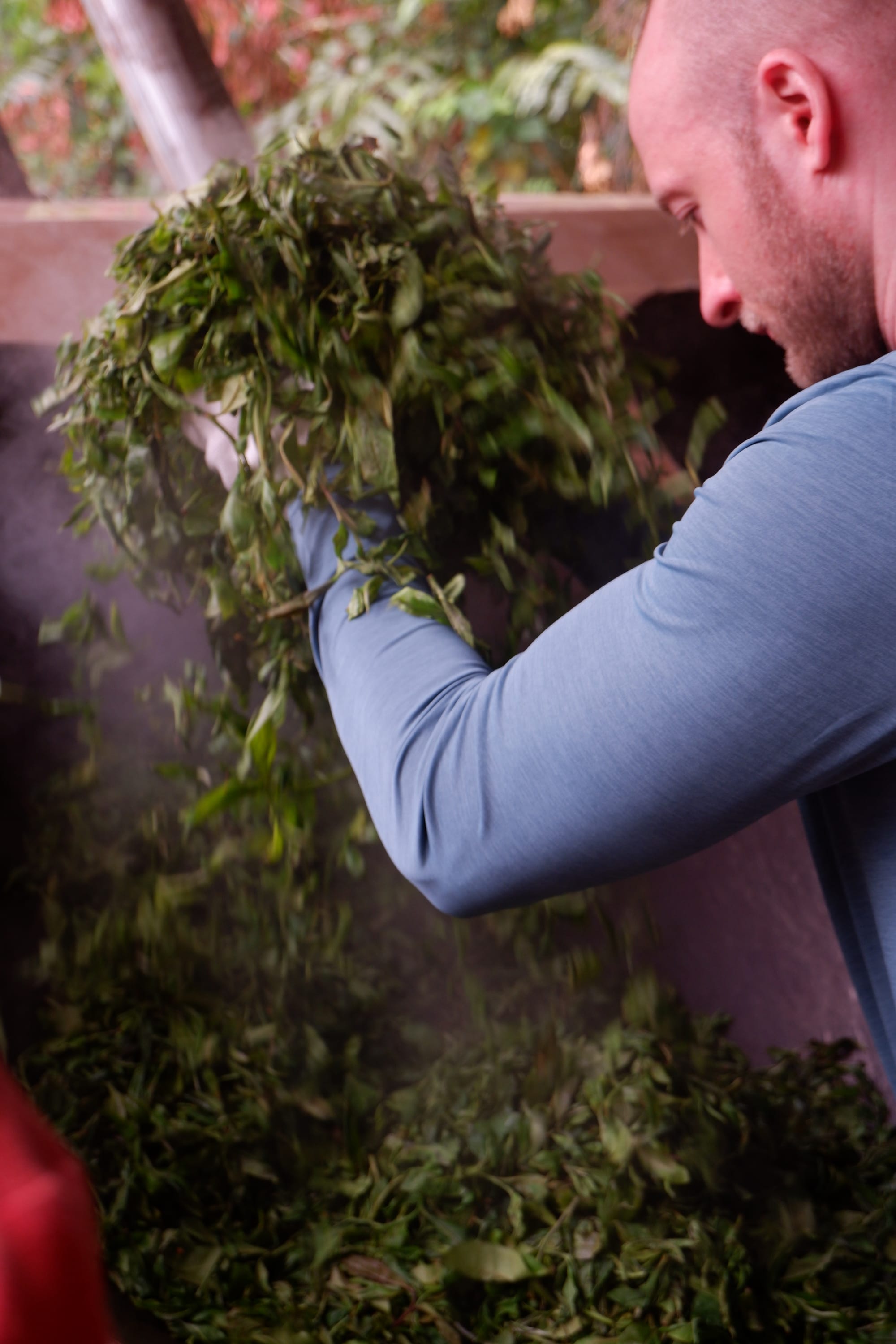
After pan firing our teas we each took turns rolling the tea. I rolled hard because our host told us it was nearly impossible to over-roll the tea. Well turns out I may have been hitting the gym a little harder than the rest of the team because my tea was rolled into a whole other animal than Jason’s (who’s questionable Tai Qi approach yielded a medium roll) and Zongjun’s (who’s fragile hands produced the lightest roll). After a few combined hours of pan firing and rolling my appreciation for pu’er will never be the same.
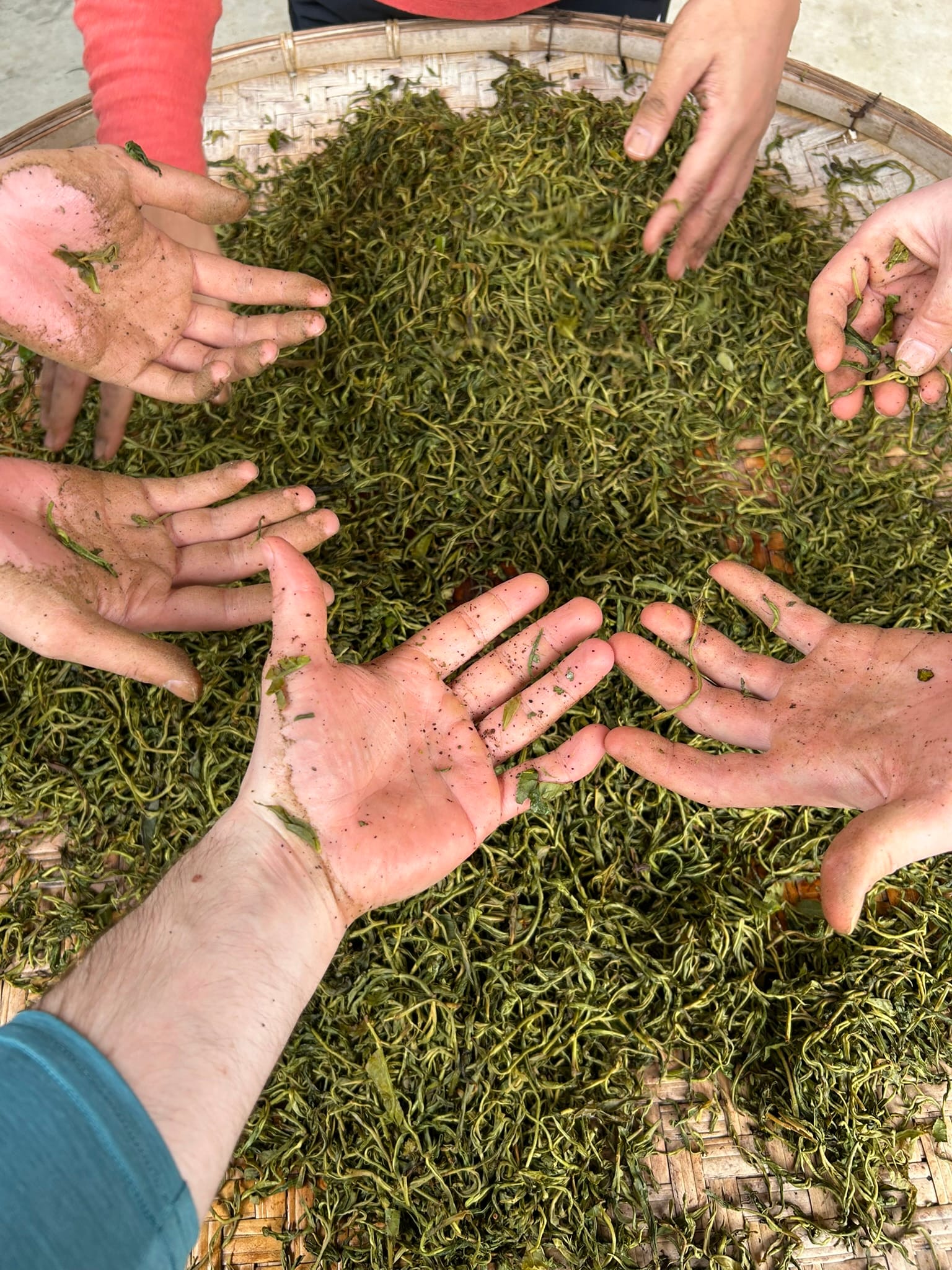
A few days later we had a chance to taste the product of our labor. The differences in heat management, evenness in firing, and rolling intensity all presented themselves as different characteristics in the cup. My strong roll yielded an immediate and solid bitterness; Zongjun’s delicate touch led to an even heat management but light flavor due to the gentle roll. We were told these immediate differences would be almost unnoticeable by the time the tea was pressed. More to come on that once we receive our teas!
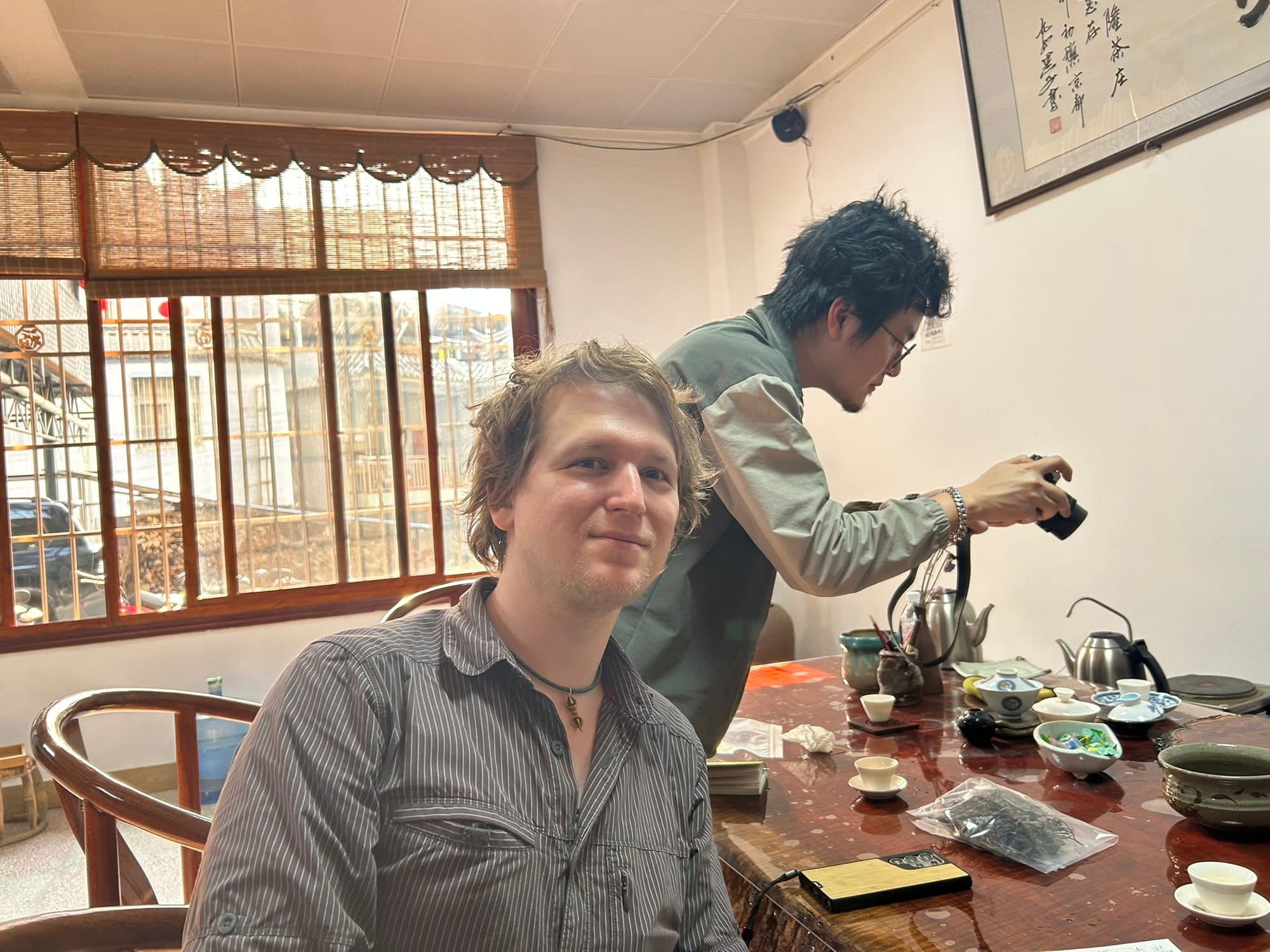
We got the chance to pan fire with our other host family another few nights. As we all practiced our technique got better and better. Eventually getting to the point where our host let us fire most of a batch solo (jumping in now and then to either dissipate some steam, heat the leaf more evenly, or prevent some burning). By the end of our trip I felt like I made a few mental connections between the weather, the condition of the leaf, and the processing technique. I definitely couldn’t process good tea solo yet, but maybe one day!
How I learned to love the sodium, lard, and chili bomb
The food. The food! How could I talk about a trip to China and not talk about the food? Yiwu was much more gracious on our stomachs than Wuyi had been the year before – but that doesn’t mean Yiwu didn’t leave a permanent mark on us all…Stretch marks to be precise. I usually leave these trips a few kilos lighter than I started, that has more to do with not working out and losing some water weight and muscle over the course of 1-2 weeks than it does our diet. However, Yiwu food made us THICC. For anyone following our Instagram our morning meals were well documented – I think we had one single day without mixian, otherwise every morning was a new mixian joint with a slightly different take on these simple noodles. Most of these spots offered pretty similar fare, but what was really fun was changing up the toppings – some mornings we went more spice heavy, some mornings were more pickled veg, some mornings were heavy on the herbs. I have a thorough love (and unfortunately now an unfillable craving) for mixian coming out of this trip.
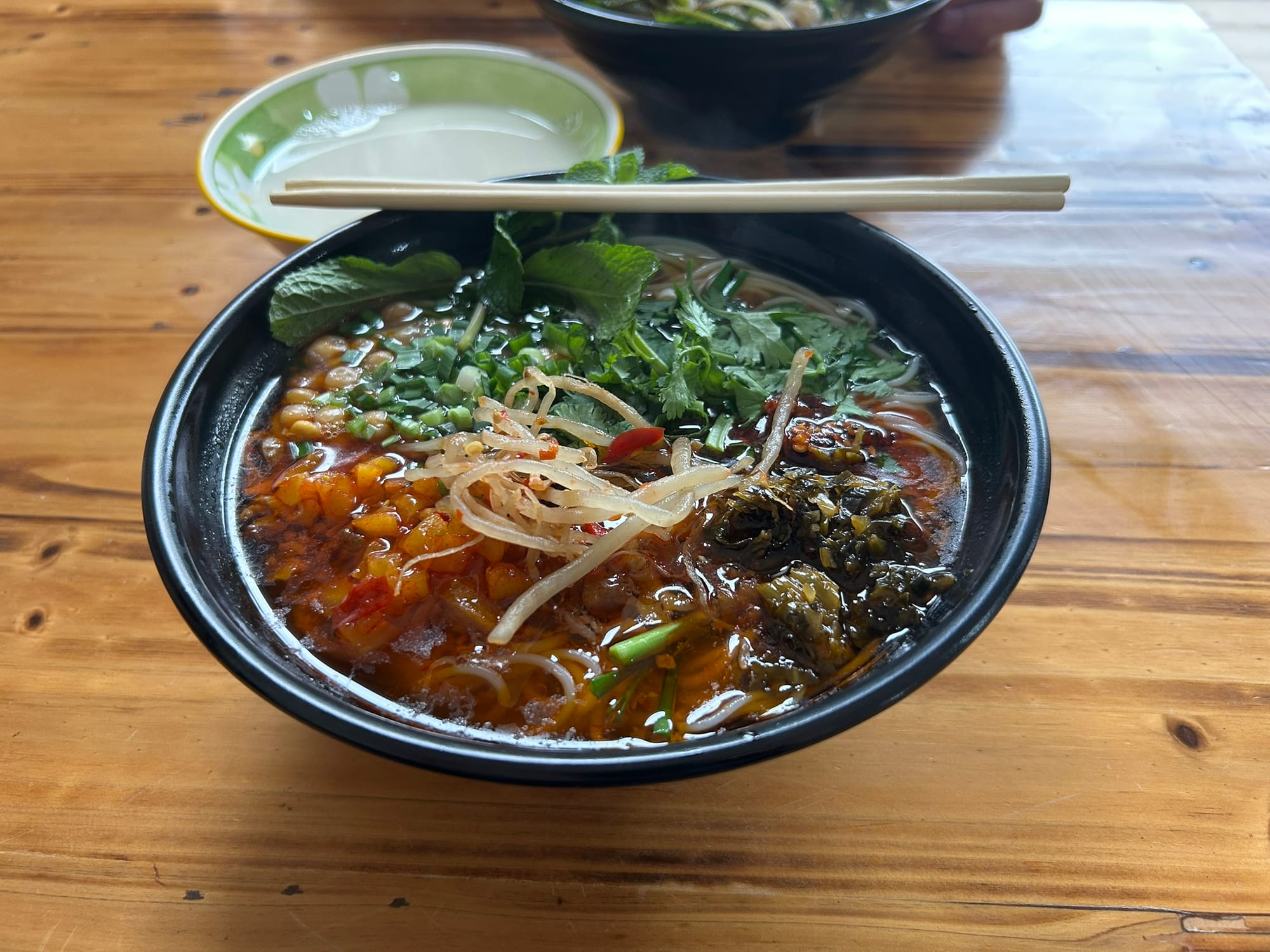
Our hosts were very hospitable when it came to meals – we ate lunch and dinner with our host families every day and there was a minimum of 6 dishes on the table at any given time (rice not included) with most meals having at least 3 different meat dishes. Yiwu is a mountain village roughly ~3 hours away from a major city, most everything we had was locally grown or raised, and often preserved through traditional means (salt cured, air dried, or even canned – meat included). Most dishes were cooked with lard, heavily salted, and the spice level was not changed on our account – with most dishes including full blown chilis with the option for more pickled chilis on the side. Add on top of that lots of interesting locally grown rice varieties, tons of freshly harvested mountain vegetables and flowers, and lots of Yunnan moldy tofu and suddenly I need to go up a pant waist size. Yes it was delicious, yes it was amazing, yes I am still about 3 kilos heavier than I was pre-trip and that doesn’t seem to be changing any time soon.
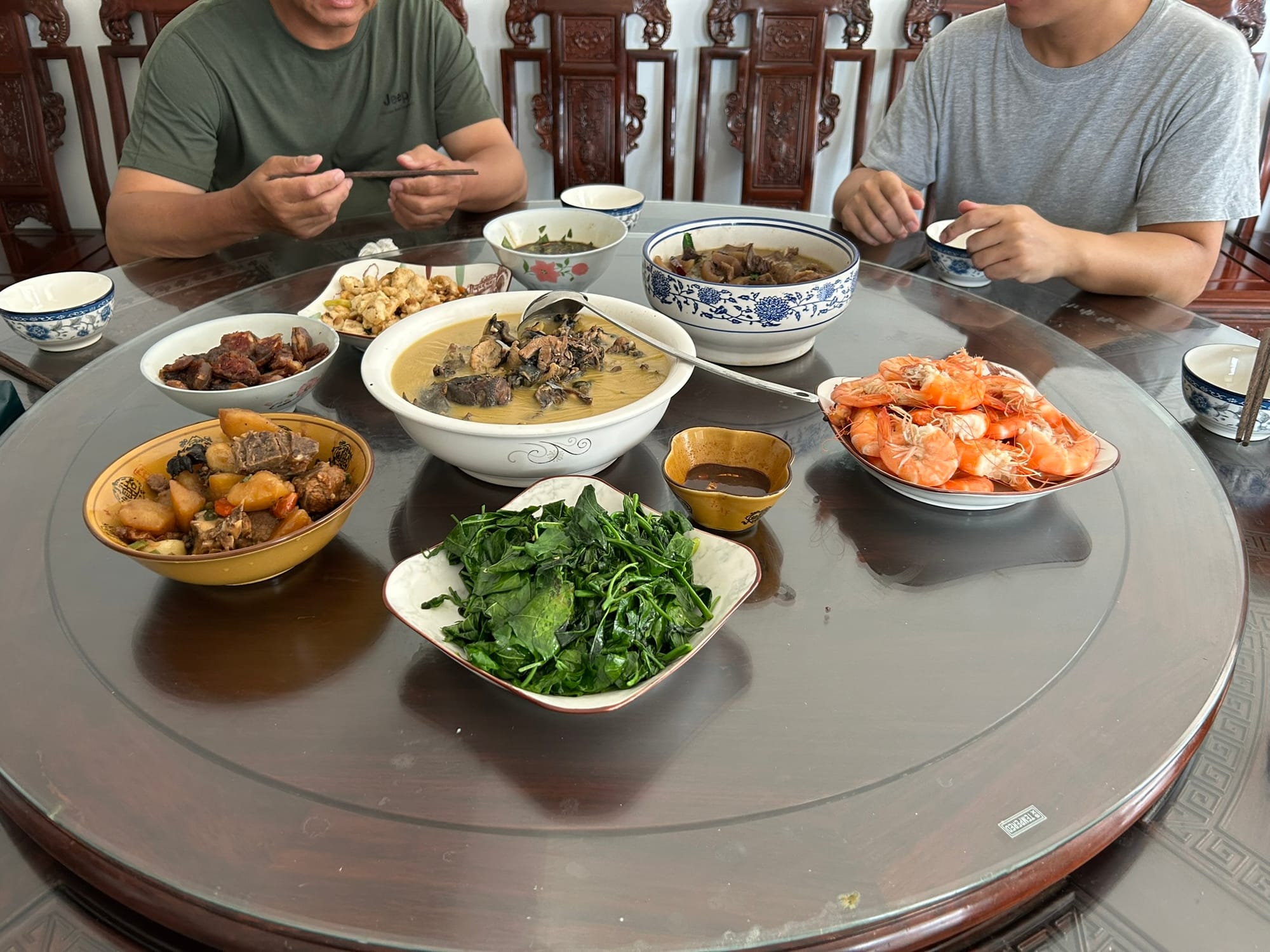
To be continued
So where does all this leave us? Well, we will be back. Yunnan, let alone Yiwu, is not something that can be understood in one trip. We will be returning to Yunnan for the foreseeable future to build relationships, learn as much as possible, and of course drink excellent tea in the pursuit of crafting the most thorough educational text on Pu’er possible. If I were to make some future predictions for myself knowing I’ll be back to Yunnan a few times in the next ~5 years it would be this: I’ll need another pumidor, I’ll need to speak better Mandarin, and I’ll need to size up to a 34 waist size on men’s pants.